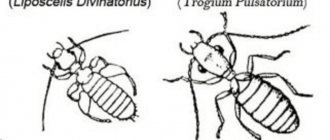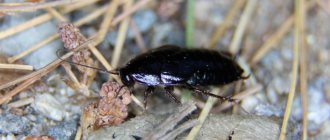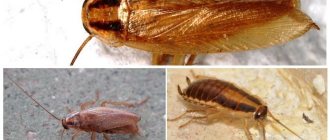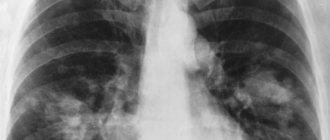Oddly enough, not all people have a clear understanding of the danger cockroaches pose to humans. In addition, many people treat these parasites as a natural phenomenon. They sincerely believe that these insects are harmless, and their crawling on the kitchen table or on the bathroom sink is not scary, but just a little unpleasant.
But they are mistaken, because the Prussians bring quite serious problems to our homes. In this article we will talk in detail about each of them.
Carries pathogens of infectious diseases
The main danger of mustachioed parasites is that they actively move not only throughout the entire apartment, but also penetrate into other places in the house. These are attics and basements, sewer lines and garbage chutes. We all know that such spaces are completely unsanitary.
It is natural that a lot of pathogenic bacteria and helminth eggs settle on their chitinous covers (the abdomen and paws are especially susceptible to this). Next, insects spread these microbes directly throughout the apartment. Very soon, the causative agents of various diseases from the bodies of insects get onto the food left on the table, into the bread bin and onto the dishes from which you eat and drink.
Cockroaches eat waste, and even animal and human excrement in sewer lines, attics and basements. This means that numerous pathogenic microorganisms accumulate in the insect’s digestive system.
During the study, it was revealed that Prussians are carriers of:
- meningitis;
- pneumonia;
- dysentery:
- salmonellosis;
- gastroenteritis;
- mycobacteriosis;
- some urogenital infectious diseases.
The greatest danger comes from barbels that enter the home from the sewer system. No one knows in what environment the cockroach recently crawled and what kind of nastiness it can leave on food after walking over it.
All the pathogenic bacteria that we talked about above can easily get on any surface in the bathroom, kitchen and toilet. A person can easily become infected with them, either through eating contaminated foods or by not washing their hands after touching dirty surfaces. As a result, a person ends up in a hospital bed and has no idea about the causes of the unpleasant disease.
It is very dangerous if Prussians enter kindergartens and schools, as they can provoke a large-scale spread of infectious diseases. Therefore, in such institutions it is necessary to begin eliminating parasites as quickly as possible.
What diseases do cockroaches carry?
Cockroaches can be carriers of various viruses and infections. Human infection can occur in two ways:
- inhalation of insect fecal fumes;
- eating foods that have been touched by cockroaches;
- using dishes on which parasites crawled.
The following diseases are carried by cockroaches:
- Diphtheria is an infectious disease that affects the oropharynx, larynx and other organs.
- Tetanus - damage to the nervous system and strain on the skeletal muscles.
- Dysentery - intoxication and damage to the gastrointestinal tract.
- Tuberculosis is a disease of the lungs.
- Ringworm is an inflammatory process that affects human skin.
- Salmonellosis is an acute intestinal infection.
- Infectious hepatitis is inflammation of the liver tissue.
- Poliomyelitis is infantile spinal paralysis.
- Leprosy is a lesion of the skin and peripheral nervous system.
Harm the nervous system, disrupt sleep
However, the danger of cockroaches lies not only in the spread of pathogenic microorganisms. Longhorned beetles crawling around the apartment cause irritation, disrupting the functioning of the nervous system. A person falls asleep in fear, which contributes to the development of insomnia. Inadequate sleep causes poor health, decreased immunity and weakness. As a result, bacteria, germs and viruses can easily penetrate an unprotected body.
Children may develop a phobia, the official name of which is blattophobia. This is a serious mental illness that causes an inadequate reaction to cockroaches in an adult.
In people with blattophobia, attacks are accompanied by increased heart rate, increased blood pressure, redness in the face and increased sweating.
The patient may squeal loudly, climb up onto a chair with his feet, or scream in fear. Parasites come to them in dreams.
Drug treatment for this disease is not enough. You will need to go to see a psychotherapist for a long time, work on yourself, and rebuild your subconscious.
Can get into the ear, mouth, nose during sleep
Cockroaches are especially active at night. They come out of their secluded places when people are already sleeping. Sometimes parasites, in search of a reliable shelter, crawl into a child or adult’s ears, mouth, nose, causing severe pain.
The structure of the human ear has its own characteristics, and therefore it is not difficult for an insect to squeeze inside the ear, but it cannot get out on its own. By moving its legs and antennae, a cockroach can injure the ear canal and damage the ear membrane.
You can only pull out a Prussian with the help of special medical instruments, so you should consult a doctor at the slightest suspicion.
Do cockroaches attack humans?
A cockroach is not a parasite. Accordingly, these insects do not purposefully attack a person and do not cause direct harm to him (in particular, they do not drink blood, like, for example, bed bugs, lice or mosquitoes).
It is also useful to read: The history of cockroach races and the features of their implementation today
And one more thing: Don’t write off Mashenka’s cockroach chalk - it really works, we tested it during the experiment...
However, even though they are not parasites, but pests, cockroaches sometimes still not only bite a person, but also create additional troubles:
- There are known cases where, when there were a very large number of cockroaches in a room, they gnawed off pieces of skin on the fingers and toes, as well as in the lip area of sleeping people. There are documented accounts of sailors who had to sleep with gloves on because cockroaches would chew the skin on their fingers, resulting in nasty sores.
- Being very dependent on the presence of water sources in the room, cockroaches can lick saliva from their lips at night and gnaw the epithelium here, especially in children. It is clear that if there are worm eggs or dysentery pathogens on the legs of such a cockroach, then such bites are also fraught with dangerous diseases.
- Red cockroaches can crawl into a person’s ear, seeking shelter here. Sometimes it can be extremely difficult to remove an insect from the ear: when you try to do this with your finger, the cockroach will hide even more stubbornly. In some cases, the victim has to see a doctor.
This is interesting
In one of the Taiwanese hospitals, a cockroach was removed from a patient’s nose and remained there for three days, continuously scratching the mucous membrane with its paws and causing a severe runny nose. After extraction, the insect was alive.
So, there are no parasitic cockroaches that purposefully and regularly bite humans. Cockroaches in the home are dangerous to humans, primarily because they carry pathogens of various diseases and can sometimes cause chronic allergies.
Allergic reactions
Another danger to humans posed by exposure to cockroaches is allergic manifestations. Chitinous coverings, which remain in large quantities after the molting of parasites, their corpses and dried excrement, are mixed with house dust and, when they get on human skin, into the respiratory system and into the digestive system, they can cause serious diseases:
- bronchial asthma;
- dermatitis;
- allergic rhinitis.
Bites
It is rare, but it happens that cockroaches bite a person. Prussians have a fairly developed oral apparatus, thanks to which they not only gnaw the surface of the epidermis, but also gnaw the neck, fingers, cheeks and eyelids. The presence of infection significantly slows down the healing of wounds.
Scientists are inclined to believe that cockroaches bite due to lack of water. For this reason, they compensate for the lack of water by licking tear fluid, saliva and sweat secretions from a sleeping person.
Also, parasite bites are caused by a sharp increase in their numbers. There is not enough food for a huge population of insects in the limited space of an apartment.
Cockroach saliva contains a protein that causes allergic reactions. As a result, the skin in the area of insect bites may develop rashes and become red. The site of the bite may feel itchy and painful.
Cockroaches are “transport” for pathogens of dangerous infections
The Latin name of the family Blattoptera gave its name to a scientifically proven phenomenon. Blattopterosis is harm to human health caused by cockroaches.
On the legs and antennae, and in the intestines of insects, 30–40 types of bacteria “travel”, including pathogenic and opportunistic ones.
Cockroaches are “transport” for pathogens of dangerous infections
Why are cockroaches dangerous in an apartment?
- mechanically spread pathogens;
- cause allergic reactions;
- swallowed with food;
- crawl into the ear and nose;
- bite.
See also - Where do white albino cockroaches come from?
Cockroaches are carriers of diseases caused by staphylococci and Pseudomonas aeruginosa. The latter is the causative agent of pneumonia, genitourinary tract infections, and pyoderma.
The bacterium quickly becomes resistant to antibiotics. Staphylococcus aureus is an opportunistic microbe. It is part of the microflora that is associated with the appearance of acne, boils, carbuncles, the development of pneumonia, meningitis, sepsis, and abscess.
What diseases do cockroaches carry?
- pneumonia, tuberculosis, salmonellosis, cholera and several dozen more bacterial infections;
- helminthiasis resulting from infection with pinworms, roundworms, whipworms, bovine tapeworms and other worms;
- amoebic dysentery, giardiasis, toxoplasmosis and other diseases caused by protozoa;
- viral diseases - herpes, hepatitis, enterovirus infections, polio;
- spores of almost 20 types of pathogenic fungi that affect various organs and tissues.
The causative agents of all of the listed diseases are not necessarily present on the integument and in the intestines of insects. Those who are in a hospital, hospital or clinic are at greater risk. If there are cockroaches in such institutions, then they have more access to pathogenic and virulent microbes.
Allergy to cockroaches
The danger of developing hypersensitivity to substances in insect feces and chitin is usually underestimated. This is often forgotten when discussing the problem of why cockroaches are harmful in an apartment. Particles of feces, chitin and dust rise into the air, settle on the skin, clothes, hair, and penetrate into the nose with inhaled air. Allergens can enter the human body with food.
Recent studies of the “Prussians” have yielded striking results. It turns out that up to 16% of all cases of allergic diseases are associated with these insects. More often than others, dermatitis, rhinitis and asthma occur, but not in every person, but mainly in people predisposed to such a reaction to irritants.
Here's why cockroaches are dangerous for people prone to allergies:
- the appearance of attacks of choking and coughing when cleaning in insect habitats;
- redness, irritation, swelling of the skin;
- severe sneezing, watery runny nose;
- pain in the eyes, swelling of the eyelids.
Strong allergens are found in cockroach excrement. Irritating substances are not destroyed by boiling or ultraviolet irradiation and retain their properties for decades. In addition, insects carry mold spores, which cause bronchial asthma in humans.
Cockroach bites
Cockroach bites
These insects rarely specifically attack humans. Therefore, not everyone knows whether cockroaches are dangerous to humans, for example, like bed bugs. The latter are blood-sucking insects; they pierce the skin with their proboscis and feed on blood.
Cockroaches are capable of biting people, especially sleeping children, whose eyelashes and skin flakes on their lips, ears, fingers, and eyelids are chewed off. Lack of water in the room leads to the fact that insects can “fall” at night into liquid discharge from the eyes and mouth. Such cases are dangerous for contracting infectious diseases.
Red, black, American and Egyptian cockroaches, the inhabitants of homes, are distinguished by their desire to bite humans. The result is irritation and inflammation of the skin (dermatitis). The reaction to a bite also depends on what the cockroaches tolerate. If there are pathogenic microbes on the paws, antennae, or in the intestines, then pustules and erosions form. Fungi and viruses can penetrate the skin.
Bite areas must be disinfected with iodine tincture, brilliant green, and alcohol. Iodine is preferable because the active substance has an antimicrobial and antiviral effect. If a rash develops, severe itching and pain occur, you should consult a dermatologist.
Cockroach as a foreign body
The insect can get into the ear and nasal passages. There is scratching and moving, which causes severe irritation and pain in a person. If the eardrum is damaged, blood appears in the ear canal.
Cockroaches are removed from the ears and nose in the hospital because the insect will not be able to get out on its own. First, the ear canal is washed with a special liquid, then the insect is removed with tweezers.
Food spoilage
Another significant harm from cockroaches to humans is food spoilage. Not their destruction, but their damage.
Scientists have been able to calculate that one thousand cockroaches eat about 10 kilograms of dry food during the year. At first glance, this is not such a large number. But imagine a situation where you saw a Prussian crawling on a plate of food. What immediately comes to mind is that this insect could very recently be running through a garbage chute or sewer. Of course, you will no longer eat this food.
The same goes for other food products. If you regularly observe parasites crawling around the kitchen, then most likely they have already gone through all the products that are not put in the refrigerator or in a tightly closed container. All these products must be thrown away, as there is a risk of serious illness.
If a cockroach was able to get inside the refrigerator, then it will, of course, run through all the products located on its shelves. From this moment on, food from the refrigerator can be safely thrown away, since it has already become inedible.
How to get rid of cockroaches?
Having discovered cockroaches in your home, you need to take urgent measures to destroy them before they have time to create an entire colony. These insects are extremely tenacious, and only the most powerful poison can destroy them.
When using cockroach repellents (sprays, traps or gels), you must be very careful, as this poison can be dangerous to human health if used incorrectly or if it accidentally gets into food. Therefore, it is most effective and safe to use the help of professional exterminators.
AfterText #1
Damage to wiring and resulting fire
Cockroaches are almost omnivorous insects. Their diet may not only consist of crumbs and food scraps. They can easily damage the insulation of electrical appliances. The structure of the insect's oral apparatus allows them to gnaw through objects made of hard materials.
When the Prussians cannot find food for themselves, they begin to gnaw on everything that comes their way. Therefore, there is a high probability of damaging the wiring. This, in turn, can cause short circuits and cause a fire in the apartment.
How else are cockroaches dangerous?
In addition to the fact that cockroaches spread infections and bacteria, they can be dangerous to humans in everyday life.
Prussians and their black brothers also often damage interior items, for example:
- Leather Products;
- indoor flowers;
- books;
- wallpaper;
In addition, cockroaches can hide in household electrical appliances, sockets and switches, which sometimes causes short circuits and fires.
Damage to valuable books and equipment
Insulation damaged by cockroaches often causes appliances to fail. There is nothing left but to throw away the failed devices and buy new ones instead.
Also, if the Prussians lack food, they begin to gnaw the bindings of books, even if these copies are of some value. Cockroaches are not interested in this at all!
Prussians love to lay eggs behind wallpaper, thereby damaging it.
Harm to pets
As soon as you notice cockroaches in your home, immediately begin exterminating them. Treat all premises yourself with insecticidal agents or call a specialized service that deals with pest control. However, a dead or paralyzed cockroach can be eaten by a pet or bird living in the apartment.
This leads to severe poisoning of the pet, as the production of toxins by the toxic agent continues. The consequences of such poisoning can be disastrous, including the death of a pet.
To prevent such troubles, during the period of disinsection, pets must be taken from the apartment to the country house, to relatives or friends.
Spread of an unpleasant odor
Black cockroaches have a pungent and unpleasant odor. They smell rotten and damp. If there are not very many longhorned beetles, then a slightly noticeable odor emanates from them. However, if the number of insects is large, then unpleasant odors spread in the apartment, which are very difficult to get rid of.
There is only one way out here - either self-disinfestation of the premises, or calling the appropriate specialists.
Are all species dangerous?
Today there are many varieties of cockroaches. Some of them pose a danger to human health, and some are practically harmless insects. The threat to humans comes from red, black and American cockroaches.
The most common parasites are red in color; they pose a great danger to people. These insects reach a length of up to one and a half centimeters, their wings exceed the body parameters in size. The red-haired parasite has long mustaches, which are needed to communicate with its fellows and navigate in space. A cockroach cannot live without its whiskers.
Black cockroaches that settle in homes also pose a danger to people. Their length can vary from 2 to 5 centimeters. The body is black or dark gray in color and has a noticeable metallic sheen. The wing size of females is slightly smaller than that of males. Moreover, the body of females is larger and can reach 5 centimeters.
The American cockroach is similar to the red cockroach; their body is larger - approximately 5 centimeters. Females are slightly larger than males. A distinctive feature of this type of longhorned beetle is the horizontally located dark brown stripes on the back. This sign helps to distinguish dangerous insects if a person is overcome by doubts about their safety.
What cockroaches live with humans?
The article Types of Cockroaches describes the varieties of cockroaches encountered by humans, but the most common species living with humans are red and black.
Red cockroaches (Prussians) are small individuals (up to 1.5 cm) of a red color with brown stripes. Insects reproduce quite quickly and increase their population. They prefer to live behind the stove, kitchen unit, under the sink, bathtub, etc.
Black cockroaches are distinguished by their larger sizes (up to 3 cm) and sulfur color. They often live in basements and sewers, climbing into human housing in search of food.










